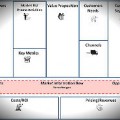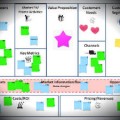As I’m gaining experience helping companies market their minimum viable products (MVP) it is quite clear that the traditional marketing plan isn’t suited for the task.
Those of you who have read me in the past know I am a big fan of Business Model Generation, Lean Startup (hence the MVP) and Design Thinking for fast moving business environments.
I have looked at various marketing plan models that somewhat followed those lines of thinking. I tried using Ash Maurya’s Lean Canvas (based on the Business Model Generation canvas), which seemed like the better alternative, but it’s still not exactly what my clients needed to organise their marketing efforts. Hence I found myself adding boxes and crossing others out on the canvas according to my customer’s needs.
After almost a year, I am on my way to a marketing plan canvas that
- Lets the user cover all the marketing bases – it also acts as a checklist
- Allows a full view of what is currently going on marketing-wise
- Is easy to work with (as most users don’t have a marketing background)
- Minimises time investment in planning
- Can be adapted for different environments and situations
This canvas is not final. I don’t think it will ever be final. As it is more of an open toolbox than a tool, it will be used differently for different jobs. It will also be used differently by different people for the same job. As with the Business Model Generation canvas on which it is based, the innovation of the MVP marketing plan doesn’t come from the concepts it contains but rather an organisation of tried and true marketing concepts to better suit the realities of today’s start ups.
 Who has time for a marketing plan?
Who has time for a marketing plan?
Inherent to the Lean Startup methodology of MVPs is the break-neck speeds at which activities need to get done. In such environments it’s very easy to dismiss planning as a waste of time.
I won’t extol the virtues of business planning in this post as I’m certain you have heard them all. I will however share with you the benefits of a marketing plan when dealing specifically with MVPs that I have observed when helping start-ups.
Benefits of a marketing plan for a MVP
 Covering your bases
Covering your bases
Often early stages start-ups don’t have marketers to help them commercialise their MVPs and the marketing that needs to be done is not always clear. The MVP marketing plan can serve as a guide or check list to ensure the marketing bases have been covered. It doesn’t by any means replace deep marketing knowledge or a full marketing plan. It can however reassure you that you are not completely in left field when it comes to getting your MVP to market.
 A visible reminder and beacon
A visible reminder and beacon
The MVP marketing plan will be on the wall in your start-up space. You will be reminded every time you look at it of the what, when, where, why and how of your MVP every day. This helps with your focus as well as accelerates decision making when it comes to the MVP issues.
Some days, ok who am I kidding every day, entrepreneurs’ head spin with the sheer amount of information they have to process, issues they have to deal with, people they have to convince and decisions they need to make. It is very easy to lose sight of why you are launching your product and who you are doing it for.
The MVP marketing plan acts as a beacon to help you get back on the right track when you don’t know which way is up any longer.
 Gaining new understandings by changing your point of view
Gaining new understandings by changing your point of view
An entrepreneurial team I worked with who were at a standstill at their 4th MVP iteration found a new use for the MVP marketing plan. They chronologically aligned all their post-its (used in the multiple MVP marketing plan iterations they went through in 6 months) in each box in the plan. Simply by reorganising the display of this information they quickly identified a subtle shift in marketing strategy, which had gone unnoticed, after the onboarding of a new resource in the company. This shift had sent them on a wrong path on their 4th MVP iteration.
It also allowed them to realise that the recent delays they were experiencing on their schedule was due to a key resource that was not the one they had initially identified as the culprit.
Finally, as I walked by their reorganised MVP plan I was able to see that they had incorporated a few vanity metrics in their last MVP iteration. When I asked them why, they humbly admitted that with their last MVP iteration not doing as well as previous ones they used these metrics to boost their moral and that of their surroundings. Some soul searching ensued.
In the second post of this series, I will show you what the MVP marketing plan canvas looks like and how to use it.
EDIT Sept. 2016 – Graphics











